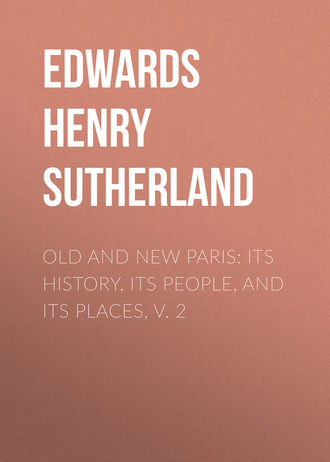 полная версия
полная версияOld and New Paris: Its History, Its People, and Its Places, v. 2
Among the other remarkable halls contained in the Palais Bourbon as it at present exists, the most important is the one in which, under the name now of Chamber of Deputies, now of Legislative Body, the French Parliament has held its sittings.
The hall arranged in 1795 for the Council of the Five Hundred was afterwards occupied by the Legislative Body of the Empire, and again, under the Restoration, by the Chamber of Deputies. In 1814 the Palais Bourbon was, as property, restored to the Prince de Condé, who left the use of it to the State for the benefit of the Chamber. The Government bought from the prince in 1827 a portion of the palace, and purchased the rest from the Duke of Aumale in 1830, the full price paid amounting to 10,500,000 francs. In 1829 the Hall of the Five Hundred was replaced provisionally by a building of wood, in lieu of which the hall as it now exists was soon afterwards constructed. After the Revolution of 1848 a wooden hall was built in the courtyard of the palace to receive the nine hundred deputies of the Constituent Assembly. This hall was invaded by the mob on the 15th of May, 1848, and demolished after the coup d’état of the 2nd of December, 1851.
The Legislative Body of the Empire was now installed in the former Chamber of Deputies until the 4th of September, 1870, when the palace of the Legislative Body was once more invaded by the mob.
The most famous parliamentary debates, however, of the French, and the most important parliamentary trials, have taken place not in the Palais Bourbon but at the Tuileries and at the Luxemburg. Under the reign of Louis Philippe, in the best days of Guizot and Thiers, debates of the greatest interest took place at the Palais Bourbon in the “Chamber of Deputies,” as the French representative body was at that time called; for with each new government the name of the assembly, as of almost every other institution in France, is changed. All public establishments are from time to time Royal, National, or Imperial; and the body which corresponds in France to the House of Commons in England is called, turn by turn, Chamber of Representatives, Chamber of Deputies, or Legislative Body. No country, indeed, has had so many legislative and governing assemblies as France, which until the Revolution was as nearly as possible an absolute monarchy. The States-General, under the ancient régime, were convoked from time to time by the king, but had no real power. The most that can be said in their favour is that they at least preserved among the people the idea of popular representation. In 1788, the year before the Revolution, there was a general demand for a convocation of the States-General, to which an unexpected reply was made by the calling together of Constituent and Legislative Assemblies. These bodies both admitted the royal veto as a bar upon their decisions. But the Convention, the Revolution having now been accomplished, recognised no counterbalancing power, no control of any kind. It governed the country through its commissaries and its committees.
The constitution of the year 3 of the Republic (1792) divided the legislative power into two assemblies, the Council of the Five Hundred and the Council of the Elders. To the former belonged the initiative, to the latter the final decision.
Dissatisfied with the working of these two bodies, Bonaparte introduced a parliamentary reform of the most remarkable kind. According to his constitution of the year 1797, the Legislative Body was to be divided into two assemblies, one of which was to discuss the laws submitted to it by the Government, the other to accept the decisions in the upper chamber without debate and simply by way of registration. After the fall of Napoleon the restored monarchy, obliged by the circumstances of the time to tolerate the existence of a parliament, formed the Chamber of Representatives, which, under the government of Louis Philippe, was succeeded by the Chamber of Deputies, destined to play an important part in the political history of the country. Under the Second Empire the governmental forms of the First Empire were as much as possible introduced. The Legislative Body and the Senate came now once more into existence, the former being empowered to discuss the laws proposed by the Government, the latter to prevent their promulgation should they, under the influence of the debates, have taken a form which the Government might consider objectionable. Under the Third Republic the French chambers have resumed something of the importance they possessed under Louis Philippe. Their powers, indeed, have been increased, though they contain no such distinguished men as those which gave character and brilliancy to the Chamber of Deputies between the years 1830 and 1848.
The assembly of the States-General held at Versailles in May, 1789, preceded by three months the taking of the Bastille; and it was in this assembly that the task-work of the peasants – their serfdom, that is to say – was abolished; that obnoxious feudal rights of various kinds were suppressed; and that religious liberty, individual liberty, liberty of the press, and general equality before the law were proclaimed.
The Bastille was taken while the assembly was in full deliberation, and this event gave to its discussions and decisions a more liberal, more revolutionary turn than ever.
The assembly of the States-General followed the king to Paris, and soon afterwards installed itself in the riding-school of the Tuileries. After the flight of Louis XVI. (June 21, 1791) it took possession of the executive power, and held it with a firm hand until the acceptance of the constitution by the king on the 14th of September. On the 30th of the same month it dispersed, to be replaced by the Legislative Assembly, to which, in virtue of a resolution proposed by Robespierre, no member of the previous assembly could belong. The number of laws, acts, and decrees passed by the assembly afterwards to be known as the Constituent amounted to not less than 3,250.
The Legislative Assembly of 1791, in which, as just mentioned, no member of the famous Constituent Assembly could sit, began by swearing allegiance to the constitution just proclaimed. A number of émigrés having assembled on the frontier, it confiscated their property, and took proceedings against the king’s brothers, the chiefs of the fugitive royalists now threatening return. It replied to the coalition against France by a declaration of war, called the country to arms, and decreed the formation of a camp of 20,000 men beneath the walls of Paris. The king making objection to these vigorous measures, the Assembly declared the monarchy at an end, and on the 10th of August it was abolished, or rather “suspended,” by law.
On the 10th of August, 1792, the Legislative Assembly, in presence of Louis XVI., decreed the “provisional suspension of the chief of the executive power,” and the convocation of a national convention – that is to say an extraordinary assembly invested by the people with full powers for reconstituting the government of the country. The members of the new legislative body were to be chosen by double election. Every Frenchman who was of age, and possessed not a house but a “domicile,” had a right to vote for an elector; and the electors thus chosen elected in their turn the members of the new assembly. There was one elector to every hundred citizens; and at the primary elections the merits of the candidates for electoral honours were freely discussed.
The procedure of the Convention was almost identical with that of the Constituent and Legislative Assembly. Many readers will be surprised to hear that among the 749 deputies forming the National Convention there were sixteen bishops, eight episcopal grand vicars, eighteen priests, and seven Protestant ministers; besides one prince of the blood (the Duke of Orleans, nicknamed Philippe Égalité), and a number of barristers and lawyers, officers of the king’s army, now disbanded; former members of the Paris Parliament, nobles, landed proprietors, doctors, men of science, men of letters, several poets, painters, and actors; a few merchants and manufacturers, and only one workman, a wool-carder named Armonville. The Convention, though a Revolutionary assembly, can scarcely be said to have been a democratic one. On the 20th of September the new representatives of the people held a preparatory sitting in the Hall of the Hundred Swiss at the Tuileries. On the 21st the Convention reassembled at the Tuileries, and notified its official existence to the Legislative Assembly, which at once deposited its powers in the hands of the new representatives of the people, who thereupon established themselves in the Riding School. The Convention did not take possession of the Tuileries until eight months afterwards, May 10th, 1793, the unfortunate king having meanwhile, been sentenced to death and (Jan. 21) executed.
When the Convention began its sittings the enemy’s outposts were only seventy-five miles from Paris, and the German powers, who had invaded France, were preparing to take a terrible vengeance on the country which, if it had not actually dethroned, had formally “suspended” the power of its king.
“Kings” exclaimed the Bishop of Blois in an excited debate, “are in the moral order what monsters are in the physical”; and in the midst of general acclamation the Assembly adopted unanimously this declaration:
The Girondists, who for some time had the upper hand in the Convention, wished to spare the king, and some of them proposed to leave the decision of his fate to the people at large; confident, no doubt, that the verdict of the nation would be, if not altogether favourable, at least not fatal to the unhappy monarch. The Girondists, however, could not get their views adopted by the Assembly generally; and in the end many of them voted for the king’s death.
The king having been tried and found guilty by the Assembly, each member was called upon to declare in writing what sentence the convicted monarch deserved. Some were for keeping him in prison until peace was made with the invading powers, and then sending him into exile on condition of his never attempting to return. The greater number, however, of the deputies were in favour of death. One, more brutal than the others, is said to have recorded his view as to the sentence that should be passed in these cynical words: “La mort sans phrase.” M. Edouard Fournier has, however, well explained, in his admirable little volume, “Les Mots Historiques,” that whereas in most cases the deputy signing the register explained, in one or more phrases, why he was in favour of a particular sentence, the sentence in this particular case was given without one word of explanation, “sans phrase” in short, as the registrar put it.
The day of the king’s sentence, one of the deputies, Lepelletier Saint-Fargeau, who had voted for death, was assassinated just after he had left the Assembly, by a former member of the Body-guard named Pàris. The Convention ordered that he should receive the honours of the Pantheon, and assisted in a body at his funeral. This incident caused a deep sensation, deeper, it is said, even than the execution of the king, which took place on the 21st of January, 1793. The deepest indignation, too, was excited by the news that among those who had voted for the king’s death was his cousin, the Duke of Orleans, the so-called Philippe Égalité, whose son, Louis Philippe, was thirty-seven years afterwards to ascend the French throne. Writing in the Revue des Deux Mondes a few years after the latter event, Châteaubriand reproached the reigning king in plain terms with being the son of a regicide. Arguing that since the execution of Louis XVI., and as a punishment for that crime, it had become impossible to establish monarchy in France, he added: —
“Napoleon saw the diadem fall from his brow in spite of his victories; Charles X., in spite of his piety. To discredit the Crown finally in the eyes of the nations, it has been permitted to the son of the regicide to lie for one moment in the bloodstained bed of the murdered man.” That Louis Philippe suffered this outburst to be published unchallenged has been regarded as a proof of his extreme tolerance in press matters. Probably, however, he thought it prudent not to invite general attention to words which, by a large portion of his subjects, would have been accepted as justifiable.
It has been said by the defenders of the “regicide” that Philippe Égalité did his best not to be present at the sitting of the Convention when sentence had to be passed on the unfortunate king; but that he was threatened by his friends of the Left with assassination unless he voted with them for the “death of the tyrant.” However that may be, he took his seat among the judges by whom the fate of his royal kinsman was to be decided, and, when it became his turn to deliver his opinion, did so in the following words: “Occupied solely with my duty, convinced that all those who have attacked, or might afterwards attack, the sovereignty of the people deserve death, I pronounce the death of Louis.”
Philippe Égalité had looked for general approval, and had voted in fear of death – which awaited him all the same, and came to him in the very form in which a few months before it had been inflicted on the unhappy Louis. When his vote was made known cries of indignation from all sides warned him that he had transgressed one of the great moral laws which are observed even by men who violate all others. Then it was that a former soldier of the King’s Body-guard, hearing of Philippe Égalité’s unnatural offence, resolved to kill him, but not being able to find him, killed another less guilty “regicide” in his place.
Very different was the feeling excited by the conduct of Philippe Égalité in the breast of the king himself. “I don’t know by what chance,” says the Abbé Edgeworth in his “Relation sur les Derniers Momens du Roi,” “the conversation fell upon Philippe. The king seemed to be well acquainted with his intrigues and with the horrid part he had taken at the Convention. But he spoke of him without any bitterness, and with pity rather than with anger. ‘What have I done to my cousin,’ he exclaimed, ‘that he should so persecute me? What object could he have? Oh, he is more to be pitied than I am. My lot is melancholy, no doubt, but his is much more so.’”
Meanwhile the faction of the Assembly which in the beginning of September, 1792, had, by its excited declamation and denunciation, brought about the massacre of the prisoners, was constantly attempting, in combination with other factions, to arrest some of the most influential members of the majority, accuse them of treason, and bring them before the Revolutionary Tribunal. On the 2nd of June, 1793, they struck their first blow; and on the 3rd of October in the same year they denounced forty-four deputies, ordered the arrest of seventy-one, and compelled many more to take to flight and seek safety in concealment. The majority was thus diminished by 150 members: the minority in fact became the majority.
Then one of the authors of these measures, Robespierre, hoping to monopolise whatever fruits they might bear, and finding no further obstacle to his ambition, became dictator in fact, bent everything beneath his will, and reigned by terror. During fourteen months he subjected the French to a ferocious tyranny. At Paris alone thirty, forty, sixty heads fell daily. At length, on the 27th of July, 1794, this monster, together with his chief accomplices, paid his reckoning, and France was delivered from an intolerable yoke. To the general desolation, grief, and alarm now succeeded the liveliest joy. The doors of many prisons were thrown open; the instrument of death ceased to ply its blade.
The Convention, free and tranquil, despite the difficulties it experienced from foreign factions, was now to pursue its way and to give France a constitution. On the 26th of October, 1795, it terminated its session.
The Conventional Assembly, at war with all the States of Europe, at war even with the French inhabitants of some of the western provinces, surrounded by distractions and dangers to which some of its own members fell victims, did not omit to encourage the arts and sciences, particularly those of practical utility, nor to found public institutions of the highest importance. The development it gave to the national schools and hospitals, to mention these alone, has already been touched upon in previous chapters. A report drawn up in the third year of the Republic by the savant Foucroy, in the name of the Committee of Public Safety, on the “Arts which had served for the defence of the Republic,” contains some interesting details. Within nine months, it was boasted, 12,000,000 pounds of saltpetre had been manufactured and stored in the magazines of the Republic, whereas, previously, the merest fraction of that quantity had been yearly produced.
A method had been introduced, moreover, for manufacturing gunpowder in a few hours with machines of the greatest simplicity. Hitherto France had been dependent on the neighbouring nations for the manufacture of steel. England and Germany had been accustomed to furnish her with this metal at a charge of about 4,000,000 francs a year. Now several factories rose in places where the production of steel had been hitherto unknown.
During the same period many improvements were introduced in the manufacture of muskets; the number of cannon foundries was greatly increased, a species of balloon was used as a war vehicle; and, to pass from war to peace, weights and measures were rendered uniform.
The system of national education with nominal charges (averaging ten francs a month), at the gymnasiums, with free lectures by the best professors at the Sorbonne and the College of France, is due to the Convention. So, too, is the famous Conservatoire de Musique, with its gratuitous teaching, which has had the effect of turning France from an unmusical into an eminently musical nation. For an interesting and valuable account of the constructive measures adopted by the French Republic, which is usually credited with measures of destruction alone, the reader is referred to Mr. Morse Stephens’s excellent “History of the French Revolution.”
Having been endowed by the Republic with a legislative body, France was never afterwards without one, though its importance varied according to the form and character of the Government. From the Riding School of the Tuileries the Assembly moved to the Tuileries itself, and governing the country as the Convention really did, it had the right, perhaps, to establish itself in the palace of the French kings. Napoleon, however, wanted the Tuileries for himself; and his Legislative Body now held its unimportant discussions in the Palais Bourbon; which remained the home of the French Parliament, under various names, until in 1871 the seat of government was changed from Paris to Versailles.
CHAPTER XXXII.
SOME HISTORICAL RESIDENCES
The Palace of the Legion of Honour – The Ministry of War – The Rue de Grenelle – TalleyrandAN interesting walk on the left bank of the Seine is from the end of the Rue du Bac along the quay to the Pont des Invalides. To many persons the most remarkable house on the Quai d’Orsay is the café of the same name, which, by reason, no doubt, of its proximity to the Ministry of War, is largely frequented by superior officers. At No. 5 is a cavalry barrack occupied under the Restoration by the King’s Body-guard. Here, up to the time of the Revolution, was the office of the Court carriages which conveyed the public of Paris to the different royal residences, but went nowhere else. In 1788, the year before the Revolution, the prices were three livres ten sols (three francs ten sous, that is to say) for Versailles and St. – Germain, nine livres ten sols for Fontainebleau, and thirteen livres ten sols for Compiègne.
Close to the Café d’Orsay stood the Palace of the Council of State, laid in ruins by the Communists on the 24th of May, 1871.
The Palace of the Legion of Honour, one of the most beautiful buildings on the quay, was erected in 1786 by the architect Rousseau for Prince Frederic John Otho von Salm Kirburg, husband of Jeanne Françoise Fidèle Antoinette de Hohenzollern-Sigmaringen. The prince was well connected, for, husband of a Hohenzollern, he was brother-in-law of the Duc de Thouars and of the Prince de Croy. He sat as deputy for Lorraine in the Constituent Assembly, commanded a battalion of the National Guard of Paris, was condemned to death by the Revolutionary Tribunal, and guillotined on the 23rd of July, 1794, four days before Robespierre, and in the same batch with the Prince de Montbazon-Rohan, M. de Beauharnais, and M. Gouy d’Arcy. He was brought to the scaffold under the name, negligently given to him by the Moniteur, of “H. Desalm-Kirbourg, Prince of Germany.”
The former palace of the princes of Salm has had almost as eventful a history as its first owners. It was put into a lottery, and won by a hairdresser’s assistant, who sold it to a man named Liertaud, who used to call himself the Marquis de Boisregard, until he was arrested for forgery, and passed from the Hôtel de Salm to the galleys of Toulon. The house was inhabited for a time, under the Directory, by Mme. de Stael, who made it the scene of those political assemblies which were destined to get her into trouble, and which, under the Empire, made it necessary for her to leave Paris and live abroad.
At last the Government bought the Hôtel de Salm, in 1803, and caused it to be arranged as the Palace of the Legion of Honour. Burnt and pillaged by the Commune, it was rebuilt on the original plan by a voluntary subscription, to which, on the invitation of the Grand Chancellor, General Vinoy, the members of the Legion of Honour contributed.
At the corner of the Quai d’Orsay, just where the Boulevard St. – Germain terminates, is the Cercle Agricole, or Agricultural Club, composed almost exclusively of landed proprietors, and one of the best clubs in every respect that Paris possesses. The “Potato Club” it is humorously called by those who have no sympathy with agricultural pursuits, and who hold with a cert writer that “cultivators of wit have generally no land, and cultivators of land generally no wit.”
There are several Government offices in this neighbourhood: the Ministries of Agriculture, of Public Works, and of War.
The Ministry of War occupies a sort of island comprised between the Rue St. – Dominic, the Rue de Solferino, and the Rue de Bourgogne, with its principal entrance on the Boulevard St. – Germain, No. 231. The Dowager Princess of Conti inhabited the mansion until 1775, the year of her death. The next occupant was the Duc de Richelieu, who was succeeded by Loménic de Brienne, Archbishop of Toulouse, and at the same time Minister of War in the year 1786, and by his brother, the Comte de Brienne, in 1789. Without being designated “Ministry of War,” the house seemed destined to be occupied by a succession of War Ministers. At last, however, it became national property, and from 1802 to 1804 it was inhabited by Lucien Bonaparte. After the proclamation of the Empire, Napoleon gave it to Mme. Laetitia Bonaparte; and it was not until the Restoration that the Hôtel de Brienne became finally the official residence of the Minister of War.
Close by, on the Boulevard St. – Germain, formerly Rue St. – Dominic, is installed the Central Depôt of Artillery. It occupies the whole of the ancient cloister of the monastery of the Reformed Dominicans, whose church is dedicated to St. Thomas Aquinas. To the right of the church portal, the little Rue St. – Thomas Aquinas conducts the visitor to a space surrounded by symmetrical buildings. He is now in the heart of the ancient convent. The large door to the right is that of the historical cloister, where the Museum of Artillery found a home until it was transferred to the Hotel des Invalides. The religious establishment, of which nothing but the church survives, was the convent of the general noviciate of the reformed Dominicans or Jacobins, founded by Cardinal Richelieu in 1631. The construction of the church did not commence till 1638. The architect was Pierre Bullet, and the foundation stone was laid by the Duchess de Luynes. It was not until nearly the middle of the next century – 1740 – that the edifice was completed. The interior is richly adorned with paintings from the brush of Blondel, Picot, Guillemot, Lemoyne, Lagrenée, Michel Vanloo, and Ary Scheffer. The church of St. – Thomas Aquinas is the most aristocratic in Paris, and a wedding within its walls possesses enormous fascination for the curious sightseer.







